Without the Colin McRae Rally series, rally racing would be virtually unknown in the United States. Well, technically, this extreme version of motorsport is simply ignored by the vast majority of American racing fans. Nonetheless, the Colin McRae series has managed to find a niche in the American gaming market with a consistent string of quality games that satisfy off-road racing fans and gearhead tweakers alike. Colin McRae Rally 4, released a scant seven months ago here in North America, was notable for its improved graphics, nominal online features, and, possibly best of all, budget price. Colin McRae Rally 2005 ups the ante--if only a bit--with improved online play, an interesting career mode, and the same solid driving model fans of the series have come to love.

Before we get to the new features, let's take a look at what hasn't changed. Most importantly, the driving model that fans of the series have come to depend on is still rock-solid in CMR2005. It chooses to err on the side of driving simulation, as the series has always done, which means the game is not a simple pick-up-and-play experience for those new to the series. If it's your first time in a rally car, you might be surprised at how demanding the cars can be to drive. Expect to spend large amounts of time offtrack in muddy embankments and playing kissy-face with the numerous trees that line the courses. This is rally racing, after all, where no road surface is taboo: Smooth asphalt, muddy gravel, and even frozen ice are all fair game, sometimes all within the same race. The experienced driver knows how to tackle each surface to get the most out of his or her car.
The vehicles in CMR2005, of which there are more than 30, have a tangible sense of weight that is especially noticeable when making jumps. There are no floaty physics here, as the cars require a tremendous amount of speed to get airborne and quite literally slam to the ground when they land--the sense of suspension trauma is noticeable and thrilling, especially when using the cockpit view. Once you gain some proficiency with the cars, you'll find your fingers constantly flicking across the Xbox controller, making minor adjustments subconsciously in an effort to keep your car moving forward as quickly as possible. Car control in CMR2005 is a delicate dance between steering corrections with the left thumbstick, throttle and brake adjustments with either the two shoulder buttons or the right thumbstick (the former being preferred over the latter for optimal car control), and subtle, timely gear shifts with the X and A buttons to keep your revs as high as possible. If you don't like the default controller configuration, the game lets you customize each button on the controller.
Though the best-known rally cars are the highly tuned 4WD models--the Subaru Impreza WRX, the Lancer Evolution VIII, the Peugeot 206, and the Ford Focus, among others--CMR2005 has a great number of classic and lesser-known rally cars, including 2WD models such as the VW Polo, the Citroën Saxo, and the VW Golf GTi; classic models such as the Ford Escort Cosworth and the Toyota Celica GT-Four; and oddities such as the Mini Cooper S and even a Nissan pickup based on the model McRae himself drove in the 2004 Paris-Dakar Rally. Notably missing from the game's car list is the Toyota Corolla, a model that found a good deal of real-life rallying success in the late 1990s.
As you might expect, cars from disparate classes feel quite different from one another, as there is a great deal of performance difference between an Audi A3 and a Mini Cooper S. What's interesting in CMR2005 is the diversity in handling between cars of the same performance class. The 2WD VW Polo, for instance, seems to have slower acceleration off the line than the MG ZR, also a 2WD. Though both cars have the same horsepower, their difference in weight (the MG ZR being about 220 pounds lighter) seems to account for the difference in acceleration. However, these differences blur when driving the top-class 4WD cars, as they are practically identical in terms of horsepower, weight, and engine displacement. Most of the cars in the game can be unlocked by winning rallies in the career mode.
Diverse car selection means little without a lot of different tracks to drive all the cars on. Here CMR2005 delivers in spades, with nine rally events available: UK, Sweden, Finland, Australia, Spain, Japan, Greece, USA, and the newly introduced German course. Each event includes eight drivable courses, though certain stages must be unlocked. While the majority of the stages are the type of traditional point-to-point circuits so familiar to rally fans, certain events include a Super Special course, which is essentially a complicated enclosed course in which two rally drivers compete head-to-head for supremacy. These SS courses can play an integral role in the outcome of a rally, as they give you an opportunity to take on your closest rival "in person" in an effort to pull out a win.
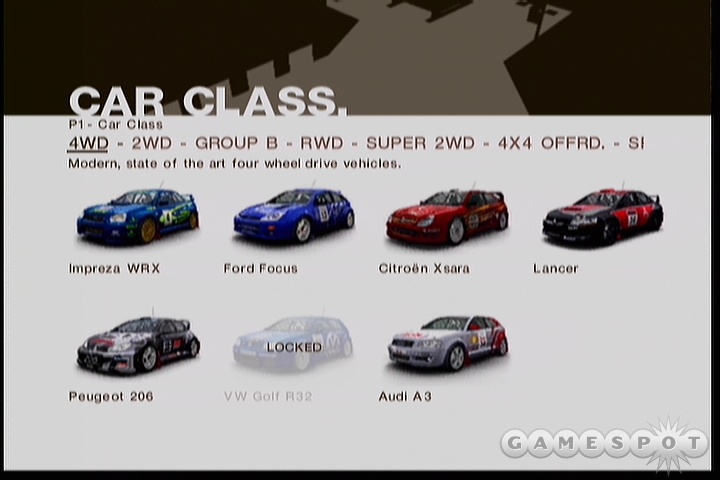
While the individual stages change from one version of CMR to the next, the characteristics of each rally event have remained true-to-life throughout the series. As in previous versions, the Finland rally event in CMR2005 is blindingly quick, full of harrowing hairpin turns in dense forest, full-throttle gravel straights, and some of the most dramatic jumps in the world. Greece, on the other hand, is a test of endurance both for the driver and the car. Heavy gravel, narrow roads with precipitous drop-offs, tire-eating stones half-hidden in the roadway, and absolutely atrocious road conditions, all hallmarks of the real Rally of Greece, are represented with dramatic flair in CMR2005. Rally driving in Sweden means running on combinations of mud and ice, dealing with snow embankments that can easily swallow your car (and add seconds to your time), and negotiating the slick surface of an iced-over stream, all while peering through your windshield during a driving snowstorm.
The feel of these different track surfaces and conditions is of paramount importance to the driving experience. Colin McRae Rally 2005 pulls off these tactile differences to great effect. Despite a disappointing lack of vibration support for the Xbox controller, there's enough visual feedback in the handling of the car on the track to realistically portray each surface and condition. Perhaps most notable in this regard is the bumpiness of some of the tracks, particularly those in Greece, where the number of undulations in the road is second only to the number of free-standing stones intent on ripping up your tires. Most noticeable in one of the three first-person camera perspectives, these bumps throw your car all over the course, especially at higher speeds. Those new to the series might find it difficult simply to keep the car in a relatively straight line on these types of difficult surfaces. On the other hand, even smooth asphalt or loose gravel can be intimidating in CMR2005, especially when they're found in narrow forest courses or accompanied by the seemingly ubiquitous rainstorms.
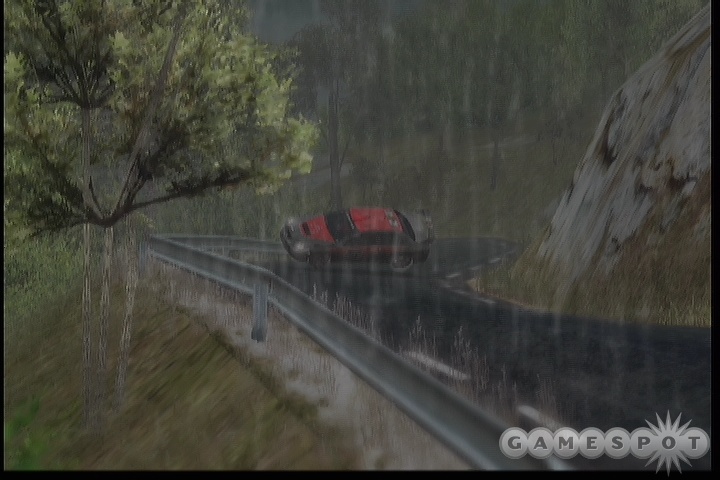
Weather plays a role in how you attack each course. This isn't the NASCAR series, after all, and there's no running for the pit lanes the second a few raindrops hit the track. Indeed, "monster rainstorm" seems to be a constant subplot in Colin McRae's championship mode, as several stages in most rally events are beset by pouring rain. This is accurate for areas with relatively high average rainfall numbers, such as Japan or Germany, but the driving rains in the Rally of Greece seem a bit out of place, as that event has traditionally been dry. Racing only individual stages or rallies lets you choose the time of day (though there is no option to race at night, as in earlier versions of the game), as well as the weather conditions you'll face.
While based on real locales, the courses in CMR2005 seem to be designed with the idea of keeping the driver as busy as possible at all times. As such, don't expect many breaks during the three- to four-minute excursions into breakneck adventure. Some courses have relatively long straights during which you can catch a breath, but they are few and far between. When you're in the driver's seat, expect to maintain ultimate concentration for as long as possible, especially in the advanced difficulty mode, if you hope to have a chance at a podium finish.
All in all, the courses in CMR2005 are varied and exciting, employing a wide spectrum of surface types and weather effects to provide you with a huge test to your video game driving skills. Some course features, such as the snowbanks on the sides of the Swedish stages and the lip at the edges of particular Greek courses, are a bit too forgiving, allowing you to effectively "bump" off them to take tight turns without scrubbing off too much speed. There probably should be more damage done to your car when executing these types of questionable driving techniques, but for the most part, CMR2005 turns a blind eye to them, sacrificing some realism for a good deal more fun. Conversely, odd roadside obstacles such as hay bales and street signs, and even amazingly dense bushes, can bring your car to a standstill quickly (and pile on the damage in the process). While certainly not realistic from a physics standpoint, this at least teaches you to keep an eye open for roadside obstacles, and do everything you can to avoid them, no matter how innocuous they might seem. The only major complaint with the tracks is the short distance of each rally stage. As mentioned, most stages take anywhere between three and four minutes to complete, some shorter, some a bit longer. This is in stark contrast to some of the behemoth tracks real rally drivers face in competition, which generally average nine miles in length and are sometimes much longer. A few tracks of this type would be a welcome addition to the CMR series, if only because it would require that much more skill, concentration, and preparation for success.
Most races are won in the pits, so goes the old motorsports axiom. While this is not entirely true, it nonetheless applies to CMR2005. Because conditions vary so widely from event to event (and indeed, from stage to stage), correct car setups are critical to your success as a rally driver. Like previous installments in the series, CMR2005 lets you adjust a number of different aspects of your car before hitting the road, including tires (the choices of which change depending on the event), ride height, springs (suspension), antiroll bar, brake bias, steering, and gearbox. As you might expect, each adjustment you make can have a dramatic effect on how your car performs once you're on the road. As such, it's important to make the right modification for the right situation. Fail to give your gearbox a push in the top end and you'll be puttering down the straights in Sweden far too slowly. If you don't soften your suspension enough, the harsh course conditions in Greece or the US will eat your shock absorbers alive.
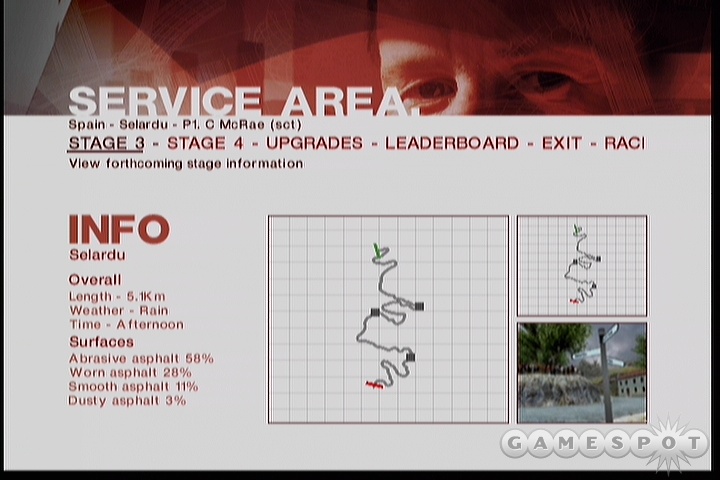
Here is where CMR2005 falls a bit flat, however. While the game gives you preview information on the next two upcoming stages, the information presented is fairly threadbare, consisting mainly of length, weather conditions, time of day, the types of surfaces you will encounter on the road, and a zoomable map that outlines each sector of the stages. While this seems like a lot, more information is often needed to make intelligent setup choices--specifically, more detail on the weather conditions. In many cases, heavy rain in the first stage becomes a light drizzle in the next, and with no information on either extreme, you often find yourself erring on one side or the other in terms of tire choice, when perhaps an intermediate tire (appropriate for damp conditions) would have been a better option. Similarly, elevation changes (which often call for lower gearbox settings) are not noted at all. As a driver, you are left to either memorize what the stage is like, or try to guess at the conditions based on what you know about the event locale in general.
While running the two stages (which are always run back-to-back in both championship and career mode), you can expect to see your car absorb some damage. A damage indicator, located in the lower left corner of your screen, gives you color-coded damage information for every major portion of your car. Slam into a wall with the side of your car and the indicator will blink, indicating damage to your car's bodywork and, depending on your speed, your suspension. Hit a tree head-on and you can expect to dent your hood severely and perhaps even sustain engine damage. There are two damage modes in CMR2005, normal and advanced. Normal allows you to take plenty of chances with the car and still be able to make it through a stage relatively unscathed. Advanced damage, however, is pretty unforgiving, even in light accidents. Drive too recklessly and you'll find yourself limping to the finish line. Damage to a car's axles or suspension is especially noticeable, causing your car to seriously favor one side or the other. That said, despite our best efforts, we were unable to completely kill a car once and for all, even after repeatedly slamming into trees with advanced damage turned on. Even running off a cliff, or completely flipping a car onto its roof after an ill-timed jump, results in a mere reset onto the course, with little damage to show for it. While damage can definitely affect your placement in a race, the game seems to want to always make sure that you at least make it to the checkered flag.

Colin McRae Rally 2005 includes several gameplay modes to choose from: a challenge mode, in which you can race individual stages or full multiple-stage rallies; a championship mode; and an all-new career mode and online racing mode for Xbox Live. Championship mode allows you to take on the persona of the Flying Scot himself, Colin McRae, as you fight for the right to call yourself world champion. There are two difficulty levels, normal and advanced. On your way to the championship trophy, you'll visit all the different rally locales on the schedule, looking for podium positions and the attendant points. At the end of the season, the driver with the most points earns the title.
During the championship season, you'll also get the opportunity to test new parts for your ride, such as advanced dampers for your suspension or an improved gearbox. These tests are essentially minigames and are generally the same as those found in Colin McRae Rally 4. The improved ceramic braking system test, for example, requires you to run a course in Spain within a predetermined span of time and stop in a designated area. Complete this exercise three times, each successive try a bit longer than the previous, and the new brakes are yours. Another test features a maddening engine-rev/gear-shifting assessment in which you are required to maintain a certain rev level in a particular gear for a few seconds, and then shift up or down to an appointed gear and maintain revs for another preset amount of time. The real difficulty comes when skipping from high revs in fifth gear to very low revs in first gear, all while on the clock. Expect to attempt this insanity-inducing test several times before passing.
The career mode is essentially a beefed-up version of the championship mode, with a few twists thrown in for good measure. You're still competing on rally courses, but, instead of running four German rally stages in a row, you might start in Germany, go to Australia, head to Finland, stop in Sweden, hit Germany again, and then return to Finland to finish off the event. In between each stage, you'll repair your ride as usual in preparation for the next stage. In this sense, it's just like a regular rally, except that the stages come from several different rally locales. Your choice of cars is limited in career mode, depending on the event you are running. You start your rally career with only a few cars in your garage, including a 4WD Impreza and a 2WD VW Polo. Using these cars as a starting point, you race in class-restricted events in which you can unlock more cars and earn driver points to unlock more-difficult racing classes, on your way to the ultimate career goal, the 4WD Diamond Series. As you move up the career ladder, the rally events become longer and are more locale-specific (an entire Spanish rally, followed by an entire Finland rally, for example).
Certainly the dedicated CMR fan will enjoy unlocking the many available cars in CMR2005's career mode. Everyone else may feel this mode is lacking in flow and narrative depth. When compared with another Codemasters title, TOCA Race Driver 2, a game whose entire premise revolved around the career of an up-and-coming driver, CMR2005's career mode doesn't really stack up. It's a bit too similar in function to the regular championship mode, in which you're simply running event after event with no payoff other than the occasional unlockable car. A rivalry with another driver, a chase for sponsorship money, or some other kind of drama would have been a big improvement to CMR2005's career mode.
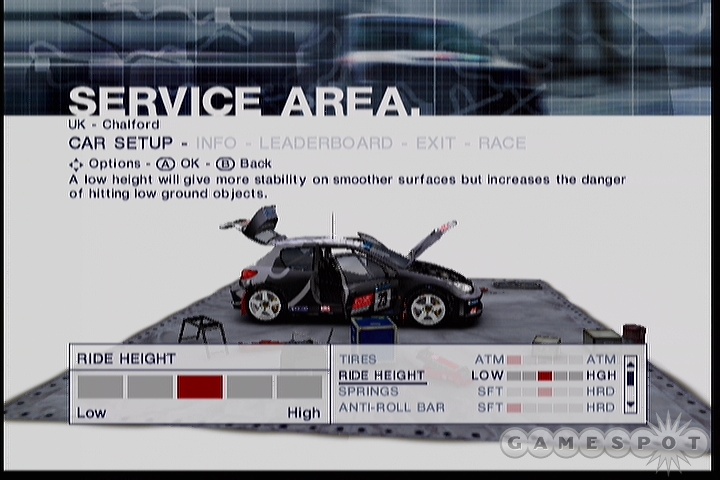
For a while now, hard-core rally fans have wondered just how a console rallying game would handle online play. After all, even though real rally races find many drivers competing against one another, the actual driving in a rally stage is a solitary event, with each driving team going out alone on the course and trying to best the times turned in by their competitors. Translating this style of play directly makes little sense for an online mode, as it would lead to loads of downtime for the drivers not currently participating in a drive and would likely end up making the mode an extremely boring affair. At the same time, simply driving a course and posting your verified times to a central server removes that much-needed interactivity that makes online gaming so immersive.
Colin McRae Rally 2005's answer to this question is unique, achieving head-to-head competition with the arcade racing convention of multiple cars on the same rally course. You can race against up to eight other Xbox Live players, but the twist is that you are racing only against brightly colored ghost cars. As you negotiate a course, you will overtake, or be overtaken by, your opponents, who may pass directly through you as you race. Surprisingly, despite the bright color palette, the ghost cars aren't really that distracting, because they fade in brightness the closer they are to you. Even when racing a car neck and neck through a series of tight turns, you'll be only vaguely aware of its presence, and it's rarely distracting enough to mess up your drive. What is distracting, however, is the lack of a codriver by default in the online mode. It's a disconcerting choice, as you're so used to hearing the codriver's voice in the offline game and counting on his instruction in order to drive at the limit. Thankfully, there is a menu option to return your trusty pace-notes reader to his seat.
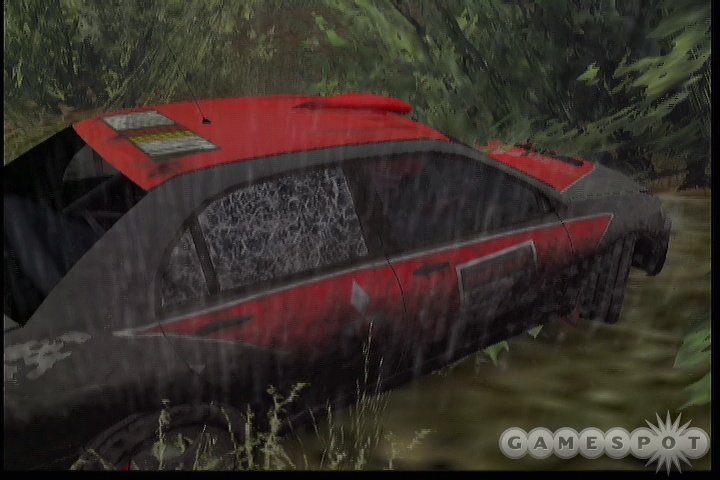
There is virtually no slowdown when playing online, even with a full complement of eight racers. With a full field, you might notice your competitors lag-hopping around the course, but performance issues with your online race should be few and far between. This is the good news. The bad news is that a lot of the features found in the offline game are no-shows on Xbox Live. Things like car setups, service-area repairs between stages (even when running full rallies), and between-stage leaderboards are all missing. No matter how recklessly you drive in a single stage, your car will be good as new at the start of the next stage. This design decision kills the rally ethic of "drive fast but save the car," which is crucial to the single-player game. Lack of car setups is another curious choice. Arguably, car setups mean more in a rally game than in any other form of racing game. No matter how fast you drive, without the proper setup--even something as basic as a tire choice--you will lose time. In addition, the stock setups they stick you with in the online stages seem to heavily favor understeer on stages that could use a bit more nimbleness in tight corners. The choice to toggle setup and repair options is sorely lacking in CMR2005's online component.
You have the choice of racing single stages or full rallies when online. As mentioned above, when racing full rallies over multiple stages, there is no between-stage leaderboard, so there's no way of knowing how much time you need to make up to take the lead. Instead, you are awarded or penalized ranking points after each stage. This ranking system is similar to the system used in Codemasters' TOCA Race Driver 2, in which the number of points you earn is based on the skill of the people you race. Beat someone who is ranked higher than you and you can expect to win a lot of points. Lose to someone of lower rank and your status will take a big hit. While CMR2005's online racing mode is enjoyable and will certainly add some life to the game, its lack of options might turn off fans of the more realistic single-player game.
Graphically, the Colin McRae series keeps making strides. This year, one of the most dramatic graphical touches is a blurred-vision effect used when sustaining heavy crashes. The more dramatic the crash, the longer and more drastic the blurred-vision effect. Slam your ride into a tree head-on at top speed and you'll not only be dealing with a severely damaged car, but you might even have trouble locating the road to get back on your way. The roadside obstacles, such as trees, rocks and huge divots, are diverse, and some even react when you hit them. Bump a tree, for example, and you'll see leaves gently falling around your car. The water effects, on the other hand, leave a lot to be desired--especially the rain effects, which, while varied in appearance (from a light drizzle to an absolutely torrential downpour), don't seem to have a sense of depth to them.
There are some seams in the textures, but you have to be at a full stop to notice most of them. Cool effects, such as sparks flying off the car when scraping against a metal bridge railing, are especially dramatic in the game's excellent replay mode, which captures the intensity of each drive well. Ranging from long views above the car to handheld-style side-of-the-road shots, the multiple camera angles mean you'll find yourself enjoying the view after particularly daring drives. Lack of camera control and no way to save your replays is disappointing, however. The color palette in CMR2005 is gorgeous, depicting dramatic lighting differences in morning and afternoon races. The lighting effects, particularly the sunlight, may be the best ever seen in the series. On one stage in particular, you are running uphill at high speeds with the sunlight glaring directly into your windshield. Unable to see much of anything, you're more dependent than ever on your codriver's pace notes.
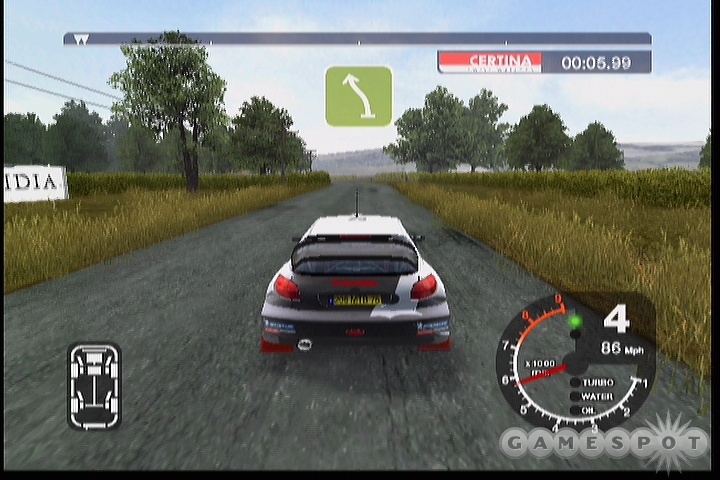
Speaking of the codriver, Nicky Grist is back in his familiar seat as the pace-notes reader in CMR2005, replacing Derek Ringer (the man who replaced him in Colin McRae Rally 4). Grist's pace notes are more accurate than ever in CMR2005, indicating road features like camber and the degree of cut to take when "cheating" across grass or gravel. Specific notes such as "Big cut inside sign" or "Turn right after blue sign" can really assist your drive. Pay close attention to the notes and learn to trust Grist's tempo and your times will only improve.
Don't expect to hear any in-race music in CMR2005, beyond the dulcet tones of Grist's pace notes. In fact, the game's only music is played in the menu system. As such, there is no support for custom soundtracks. The other aural elements in the game are solid, including a wide variety of authentic engine sounds for the various cars in the game and a good degree of variety in road-surface sounds. As you might expect, these environmental sounds are different depending on your preferred camera option--engine sounds in the cockpit view, for example, sound much different from those in either of the chase cams.
In the end, Colin McRae Rally 2005 upholds the fine tradition the series has established. A solid driving model is bolstered by a good career mode and online racing that provides a glimpse at where the franchise may be heading in the future. For those new to the series, Colin McRae 2005 offers a lot to keep you busy, and it's certainly worth its relatively low price. Those who already own Colin McRae Rally 4, however, may find 2005's online mode too sparse to justify a new purchase.